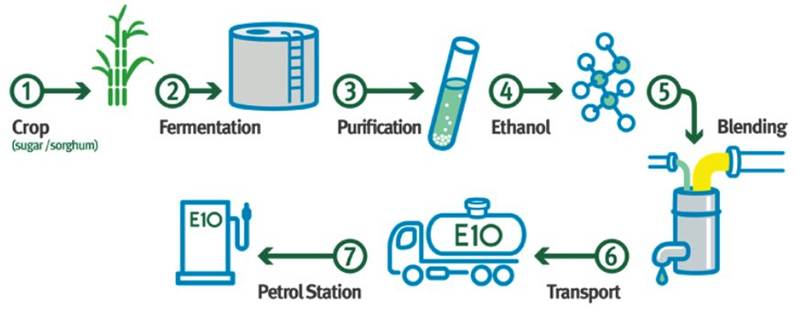Concept and Context
- Ethanol Blending = Mixing ethanol (ethyl alcohol, C₂H₅OH, produced mainly from sugarcane, rice, maize etc.) with petrol.
- E20 = Petrol with 20% ethanol.
- Policy Goal: National Policy on Biofuels (2018) targeted 20% blending by 2030 → Achieved in 2025 (five years early).
- Global Context: Brazil and U.S. are ethanol leaders (blending rates >50%). India is catching up due to oil import dependency and climate goals.
Relevance : GS 3(Environment and Ecology) , GS 2(Governance)

Economic Impact
- Foreign Exchange Savings:
- Since 2014–15, India claims savings of ₹1.4 lakh crore via petrol substitution.
- Public Sector Benefits:
- PSUs (IOC, BPCL, ONGC) dividends surged (255% rise since 2022–23) but petrol prices passed to consumers dropped only ~2% despite ~65% fall in crude oil prices.
- Suggests benefit absorbed by state revenues, not by end consumers.
- Farmer Income:
- ~₹1.20 lakh crore paid to farmers since FY15 via ethanol procurement.
- Sugarcane ethanol supply grew from 40 crore litres (FY14) → 670 crore litres (FY24).
- Agricultural Shift:
- 22% of sugarcane projected to go to ethanol by 2034 (OECD-FAO).
- But creates dependence on water-intensive sugarcane; diversification into rice, maize underway but leading to food–fuel trade-offs (e.g., India imported 9.7 lakh tonnes corn in 2024–25).
Environmental Impact
- Positive:
- Govt claims 700 lakh tonnes CO₂ emission reduction due to ethanol blending.
- Lower carbon intensity than petrol.
- Concerns:
- Sugarcane water footprint: 60–70 tonnes of water required per tonne sugarcane.
- Maharashtra & UP: excessive groundwater extraction → desertification & land degradation (30% of India’s land degraded).
- Climate stress (heatwaves, droughts) worsens sustainability concerns.
- Diversification: Some ethanol now from rice, maize → but risks food security vs fuel security dilemma.
Consumer Impact
- Vehicle Compatibility:
- Since 2023, all new vehicles E20-compatible.
- Older vehicles: require material changes (rubber, elastomers, fuel system).
- Mileage & Maintenance:
- Survey (LocalCircles): 2 in 3 vehicle owners oppose E20; only 12% support.
- Concerns: reduced mileage (ethanol has lower energy density than petrol), higher maintenance costs.
- Govt Response:
- Admits “marginal drop” in efficiency (~6-8%), claims can be offset with tuning.
- NITI Aayog recommended tax incentives to offset consumer losses.
Geopolitical & Trade Dimensions
- U.S. Pressure: Trump-era & current U.S. trade reports label India’s ethanol import restrictions as “trade barriers.”
- Indian Stand: Domestic industry (ISMA) opposes relaxation; fears undermining investment in domestic ethanol capacity.
- Global Ethanol Market: Opening imports could lower prices but hurt Indian sugar mills and farmers.
Energy Transition Angle
- Short-term Role:
- E20 helps cut oil imports, improves farmer income, and marginally lowers carbon emissions.
- Long-term Conflict with EV Push:
- EV adoption = ~7.6% in 2024. Govt target = 30% sales by 2030 → requires >22% annual growth.
- EVs have far greater decarbonisation potential than ethanol-blended petrol.
- Challenges to EVs:
- Dependence on rare earths (magnets, batteries). India imports REEs, mostly from China → recent supply shocks (e.g., germanium export curbs).
- Automakers (e.g., Maruti Suzuki) cutting EV production targets due to rare earth shortage.
Unresolved Questions
- Beyond E20?
- Petroleum Ministry suggested moving beyond 20% blending.
- Govt (March 2025) clarified no decision yet.
- Debate: Should India push for E30+ blending or focus resources on EV transition?
Summary of Impacts
- Positive:
- Reduced crude oil import bill.
- Higher farmer incomes via assured procurement.
- Moderate CO₂ emission reduction.
- Negative/Concerns:
- Water stress from sugarcane, land degradation.
- Food vs fuel dilemma (rice/maize diversion).
- Consumer resistance due to lower mileage & higher costs.
- Benefits of forex savings not directly passed to public.
- Risk of delaying EV transition due to heavy ethanol investment.



